A recent issue of Popular Music contains a review of Tim Riley's armchair listening guide to the Beatles, Tell Me Why, that concludes with the following statement: "No amount of academic analysing could capture the sheer geniality, innocence and barely bottled-up exuberance of ["She Loves You"]: Riley tries it, but you sense that even he feels it is unnecessary."1 Now, many things in this life are unnecessary. Perhaps it is sufficient to say, as did Duke Ellington, that "if it sounds good, it is good." (For some intuitively-minded conservatory students, it is certainly sufficient.) Ellington's observation is profound, but it is one that begs every musical thinker to attempt to explain why what sounds good is good. Because our reviewer seems to hold the academic and the exuberant to be antithetical, perhaps he should be reminded of Philip Tagg's words of a decade ago:
The serious study of popular music . . . is a question of (a) getting together two equally important parts of experience, the intellectual and emotional, inside our own heads, and (b) being able as music teachers to face pupils whose musical outlook has been crippled by those who present "serious music" as if it could never be "fun" and "fun music" as though it could never have any serious implications.2
The aim of this essay is to expose the musical means of expression of geniality and exuberance in the Beatles' simple early song, "She Loves You," using the "serious" tools of academic analysis that pertain to issues of voice leading and harmony. Other Beatles songs, primarily those produced through 1965 (thus representing the earlier half of their recorded catalog, quantified by their output of singles and albums from 1962 through 1970), will be cited in relation to "She Loves You."
The Beatles' ardent early works cohere by virtue of a greater degree of structural tension than is heard in most of their later work. Support for this argument can be found in the sparing, calculated use for dramatic effect of registral contrasts and rhythmic emphasis, in the clever announcement of harmonic and voice-leading events from the body of a song by its introduction, in the commanding strength of the expansion of structural harmonies and in the powerful retransitions based on elaborated dominants, variously expressive of either ecstacy or pain. The Beatles' early music displays a substantial variety of dissonance treatment and a rich exploitation of scale-degree functions, on both surface and structural levels, usually in an unambiguous setting of an idea in the poetic text.
The tonal mechanism in a fair amount of rock music is based on counterpoint, not only at the surface, but also at structural levels. Unlike much of the later music of the Beatles, the crucial means of expression in "She Loves You" lies not in its timbral, electronic, improvisatory or otherwise idiosyncratic elements, but almost purely in its rhythms and its straightforward tonal voice leading. This makes Schenkerian analysis one logical tool for the understanding of this song, despite the fact that Schenker died a generation before the emergence of this genre and style, and also despite the fact that neither Lennon nor McCartney were trained in species counterpoint.
Example 1 consists of three voice leading sketches, labelled "a," "b," and "c."
Example 1: Analytical sketch of "She Loves You"
Example 1a:

Example 1b:
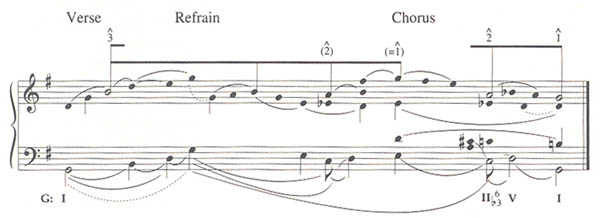
Example 1c:
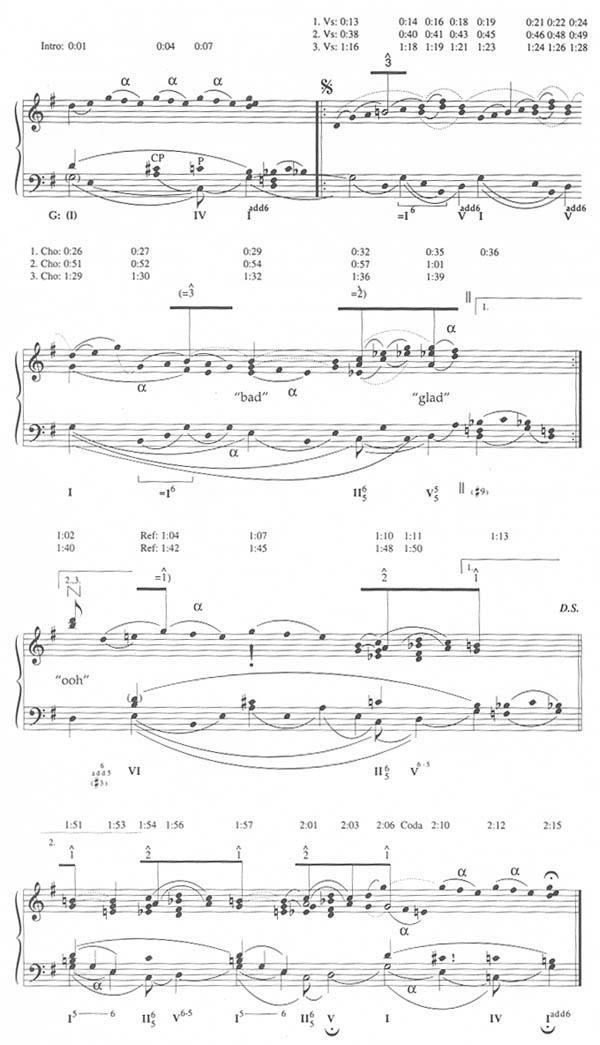
These sketches render the structural relations among voices in "She Loves You" at background, middleground and foreground levels, respectively. The background contains the descent of the fundamental line from the third scale degree, above the harmonic arpeggiation, I-V-I. Note in Example la the voice in the alto register, G4- 4-G4. At the middleground level, shown in Example lb, this inner voice is taken up into the highest register: G5 is achieved at the opening of the chorus and again, via
4-G4. At the middleground level, shown in Example lb, this inner voice is taken up into the highest register: G5 is achieved at the opening of the chorus and again, via  5, at the beginning of the refrain. (The poetic texts of the verse, chorus, and refrain are identified in Ex. 2.) The end of Example 1c indicates that the song's coda again highlights this high register with reference to the inner-voice material. Example lb also depicts the structural value of non-diatonic tones: chromatic inner-voice descents involving
5, at the beginning of the refrain. (The poetic texts of the verse, chorus, and refrain are identified in Ex. 2.) The end of Example 1c indicates that the song's coda again highlights this high register with reference to the inner-voice material. Example lb also depicts the structural value of non-diatonic tones: chromatic inner-voice descents involving  4 and
4 and  4, and an upper neighbor figure involving
4, and an upper neighbor figure involving  4, all appear at middleground levels. Another interpretation of Example lb would highlight the different voice-leading functions of the song's formal sections: the chief melodic function of the verse is the opening up of tonal space through an arpeggiation up to the primary tone, the third scale degree. The chorus emphasizes the inner-voice G in two different registers connected with a dotted slur and makes a structural move with an appearance of the second scale degree over a dominant preparation. With the completion of the fundamental line and a return to tonic, the refrain hints at fulfillment.
4, all appear at middleground levels. Another interpretation of Example lb would highlight the different voice-leading functions of the song's formal sections: the chief melodic function of the verse is the opening up of tonal space through an arpeggiation up to the primary tone, the third scale degree. The chorus emphasizes the inner-voice G in two different registers connected with a dotted slur and makes a structural move with an appearance of the second scale degree over a dominant preparation. With the completion of the fundamental line and a return to tonic, the refrain hints at fulfillment.
Example 2: "She Loves You"
(Introduction:)
She loves you, yeah, yeah, yeah,
She loves you, yeah, yeah, yeah,
She loves you, yeah, yeah, yeah, yeah.
(1. Verse:)
You think you've lost your love,
well, I saw her yesterday.
It's you she's thinking of,
and she told me what to say.
(Chorus:)
She said she loves you,
and you know that can't be bad.
Yes, she loves you,
and you know you should be glad.
(2. Verse:)
She said you hurt her so,
she almost lost her mind.
But now she says she knows,
you're not the hurting kind.
(Chorus) Ooh!(Refrain:)
She loves you, yeah, yeah, yeah
She loves you, yeah, yeah, yeah
With a love like that,
you know you should be glad.
(3. Verse:)
You know it's up to you,
think it's only fair.
Pride can hurt you too;
apologize to her
(Chorus:)
Because she loves you,
and you know that can't be bad.
Yes, she loves you,
and you know you should be glad,
Ooh!
(Refrain; repeat final couplet twice)
©1963 Gil Music Corporation. Used by permission.
As shown in Example 2, the poetic text of "She Loves You" has the singer's persona consoling a friend who believes that he has lost his love, with the news that she is ready to forgive him for his past offense, which goes nameless. "She Loves You" and many other early Beatles songs have been dismissed for their juvenile (read, "artless") lyrics, as they often are simply joyful celebrations of adolescent love. But these songs are powerful in their vocal exuberance—as Simon Frith has said, Lennon's music "involves an urgent eagerness to be heard"—and the poetic text of "She Loves You" seems the perfect vehicle for such urgency.3 Lennon spoke many times about his goal of direct communication with his audience; perhaps the most pertinent discussion concerns the minimalist lyrics of "I Want You (She's So Heavy)." In response to a criticism as to the simplicity therein, Lennon said, "But when it gets down to it, when you're drowning, you don't say, 'I would be incredibly pleased if someone would have the foresight to notice me drowning and come and help me,' you just scream."4
As is true of the Beatles' previous single, "From Me to You," Lennon and McCartney wrote "She Loves You" together while touring, a short time before the scheduled recording date.5 "She Loves You" was taped on 1 July 1963, most likely live without overdubs. (It is impossible to be certain on this point, as this fact does not yet seem to be documented and the original two-track working tapes that preceded the mono master do not survive, but the Beatles performed the identical arrangement live in concert on many occasions, so overdubs would not have been necessary.)6 The recording seems to feature John Lennon's lead vocal and electrified acoustic Gibson J-160E Jumbo guitar, Paul McCartney's Hofner 500/1 bass and descant vocal (which is nearly always in parallel thirds above Lennon's), George Harrison's vocal (which normally doubles McCartney's part at the unison for occasional emphasis, but is tacet for much of the song) and brand-new Gretsch PX6122 Country Gentleman guitar, and Ringo Starr's newly-purchased Ludwig Super Classic drum kit. The Beatles' producer George Martin has revealed that the group originally began the song with the verse, and that he suggested that the refrain would make for a stronger opening. (Martin had to make a number of structural decisions as to introductions, numbers of choruses, etc., during the group's first year or so of recording.)
The surface of "She Loves You" is tension-filled. This is partly due to a strong rhythmic drive created by such devices as the strongly accented beat-dividing syncopations in Lennon's strumming throughout and in the snare pattern that follows the "yeah yeah yeah" motto within the refrain; the stop-time fourth-beat rests emphasizing the line "with a love like that" near the end of the refrain; the unexpected repetitions of the final phrase of the last refrain (analogous to a pair of deceptive cadences that are finally set right); and the suspension of the tempo at the dramatically embellished fermata on the song's structural dominant seventh. All of these aspects mark other early Beatles songs: the drum syncopations are reheard in the chorus of "Ticket to Ride," the fourth-beat rests characterize the chorus of "One After 909," the repeated deceptive cadences conclude "I Want to Hold Your Hand," and a closing caesura graces "In My Life."
The surface feature that represents the greatest tension, however, is the two-part falsetto "ooh" that appears in the middle of the second system of Example 1c, on a structural dominant at 1:02 and 1:40. (Specific points in the composition will be referred to by the timings programmed into the CD; these timings are given above the analytical sketch.) Sociologists know that 1:02 and 1:40 are the two points at which the performers shook their famous haircuts, leading to surges of audience hysteria (and this of course is preserved in films, including the final—mimed—stage performance in the 1964 film, A Hard Day's Night).7 In two earlier songs that had been recorded on the same day in March, 1963, "From Me to You" and "One After 909," a climactic retransitional dominant had been made dissonant as an augmented triad. At 1:02 in "She Loves You," the fifth of the dominant triad, A, is altered otherwise: Lennon's voice ascends to its upper neighbor, B5, a falsetto octave above the baritone's prolonged second scale degree A4, which had been established at 0:32 (note that the sketch in Ex. 1c locates all vocal parts in their functioning registers—an octave above their sounding registers). This ascending registral shift complements a descending shift heard at 0:27, at the beginning of the chorus, as both McCartney's and Lennon's voices shift down from G5 to G4.8 The transfer seems to bind together the corporeal world of the low register with the emotion-charged upper register; the combination of the two registers at the falsetto dominant seems then to express both a physical and a spiritual ecstacy.
In fact, McCartney's D6 at 1:02 is twice removed from its "proper" register. Because this scale degree is not part of the fundamental line, the sung D always represents an inner voice. This fifth scale degree ascends from its normal, "inner," D4 (where it is sung at the beginning of the verse, at 0:12) to the descant D5 at 0:14—see the dotted slurs in Example lc—so as to prime the upper register for the chorus, which carries the text "she says she loves you," giving strong exposure to the singer's main message, an idea that had remained hidden until this point. McCartney's ecstatic ascent to the next octave, D6 in falsetto, takes this inner-voice thought to its fleeting highest level of consciousness, while that fifth scale degree simultaneously doubles the physically secure low D in the bass, intensifying harmonic tension.
In "She Loves You," expressive registral placement is married to thematic design. In Example 1c, the "α" sign in both the introduction and the refrain marks the passing motion, from G5 through  5 to E5, that is the vehicle for the emphatic "yeah, yeah, yeah." In the song proper, this motive is first heard at the beginning of the chorus, played by Harrison's electric lead guitar at 0:26 in a structurally lower register. At the beginning of the chorus, the friend for whom the song is performed is glum, downcast—that is why the word "bad" is sung at 0:29 on the low E4 and is harmonized in minor by the submediant (this lowest motion from G3 to E3, in the bass, is also marked with the "α" sign and initiates a descending arpeggiation of the supertonic six-five harmony, a gesture that is recaptured in the plagal coda, there on the major subdominant. In the final refrain, beginning at 1:51, the same direct bass motion from G3 to E3 precipitates the deceptive endings mentioned previously). In the chorus, the guitar's mid-register repetition of the "yeah, yeah, yeah" motive might be heard either as a representation of the glum friend's tired reaction to the advice he believes he has heard before, or as an extension of the singer, who expresses his message in the glum friend's lower register so as to seem particularly sympathetic. With the latter hearing, the guitar acts as if it is attempting to raise the friend's chin, by emphasizing a line, G-
5 to E5, that is the vehicle for the emphatic "yeah, yeah, yeah." In the song proper, this motive is first heard at the beginning of the chorus, played by Harrison's electric lead guitar at 0:26 in a structurally lower register. At the beginning of the chorus, the friend for whom the song is performed is glum, downcast—that is why the word "bad" is sung at 0:29 on the low E4 and is harmonized in minor by the submediant (this lowest motion from G3 to E3, in the bass, is also marked with the "α" sign and initiates a descending arpeggiation of the supertonic six-five harmony, a gesture that is recaptured in the plagal coda, there on the major subdominant. In the final refrain, beginning at 1:51, the same direct bass motion from G3 to E3 precipitates the deceptive endings mentioned previously). In the chorus, the guitar's mid-register repetition of the "yeah, yeah, yeah" motive might be heard either as a representation of the glum friend's tired reaction to the advice he believes he has heard before, or as an extension of the singer, who expresses his message in the glum friend's lower register so as to seem particularly sympathetic. With the latter hearing, the guitar acts as if it is attempting to raise the friend's chin, by emphasizing a line, G- -E in the sympathetic mid-register, that will prove to be one of emphatic encouragement when it comes to the fore in the voices an octave higher in the refrain. It is as if the guitar, by pointing, gesturing towards a higher octave, is telling the friend that he should rise to his beloved's higher level.
-E in the sympathetic mid-register, that will prove to be one of emphatic encouragement when it comes to the fore in the voices an octave higher in the refrain. It is as if the guitar, by pointing, gesturing towards a higher octave, is telling the friend that he should rise to his beloved's higher level.
This listener, however, prefers the former reading, in which the guitar symbolizes the reaction of the friend, who is filled with self-doubt. Through the guitar's "α" motive, the friend mocks the singer's news ("yeah, yeah, yeah—I've heard it all before"), and in the chorus's first ending, at 0:36, the guitar's low-register blue-note lick, with its strong hint of an aggressive dominant  chord, makes the friend sound like he's sulking. (Harrison's melodic emphasis of the blues-derived minor third G3-
chord, makes the friend sound like he's sulking. (Harrison's melodic emphasis of the blues-derived minor third G3- 3 at 0:36 transposes both the diatonic motto G-E and the mixture-produced C-
3 at 0:36 transposes both the diatonic motto G-E and the mixture-produced C- of the half-diminished supertonic chord articulated in first inversion at 0:32—because of the different origins of the inflections of scale degrees, all three minor thirds carry different messages.) In the second verse, the singer reveals that he speaks from a privileged position, as he is likely aware of the details of the past hurt for which his friend feels guilt, and so the falsetto shriek at the end of the second chorus at 1:02 gets through to the friend, who may be convinced of the promised redemption and gladness and who may be somewhat uplifted by the refrain's upper-register "yeah-yeah-yeah"s. (The friend is possibly also affected by the singer's sympathetic ear, an attitude portrayed by the conjunction of Lennon's
of the half-diminished supertonic chord articulated in first inversion at 0:32—because of the different origins of the inflections of scale degrees, all three minor thirds carry different messages.) In the second verse, the singer reveals that he speaks from a privileged position, as he is likely aware of the details of the past hurt for which his friend feels guilt, and so the falsetto shriek at the end of the second chorus at 1:02 gets through to the friend, who may be convinced of the promised redemption and gladness and who may be somewhat uplifted by the refrain's upper-register "yeah-yeah-yeah"s. (The friend is possibly also affected by the singer's sympathetic ear, an attitude portrayed by the conjunction of Lennon's  (at 1:11) and McCartney's
(at 1:11) and McCartney's  (at 1:13); the singer has apparently heard the friend's blue
(at 1:13); the singer has apparently heard the friend's blue  chord in the guitar, but still concludes that he should be "glad.")
chord in the guitar, but still concludes that he should be "glad.")
But the return of Harrison's sulking pentatonic blue-note lick in the refrain's first ending seems to indicate that although the friend may comprehend the situation, his stubborn pride threatens to stand in the way of reconciliation. In the third and final verse, the understanding singer approaches the core of his friend's soul even more closely and addresses that pride, in the intimate low register where the friend would recognize such inner emotions. The singer tells his friend that he is too involved with himself, and that by apologizing he can redeem himself and attain the woman's higher level in the upper register at 1:39, where G5 moves to  5, interrupting the completion of the "α" motive until the friend commits himself. The commitment is made at 2:06, where the affirmative completion of the fundamental line elides with the guitar's "α" motive. (The closure of the fundamental line is confirmed by McCartney's high tenor D5-G5,
5, interrupting the completion of the "α" motive until the friend commits himself. The commitment is made at 2:06, where the affirmative completion of the fundamental line elides with the guitar's "α" motive. (The closure of the fundamental line is confirmed by McCartney's high tenor D5-G5,  -
- , leaving the guitars to resolve in the coda, at 2:12-2:15, his vocal seventh abandoned after the fermata.) The song's final "yeah," at 2:15, is sustained without a trace of doubt, suggesting that the message has finally gotten through, loud and clear, and that the friend has indeed resolved to give up his pride and work towards the redemption of the high register.9
, leaving the guitars to resolve in the coda, at 2:12-2:15, his vocal seventh abandoned after the fermata.) The song's final "yeah," at 2:15, is sustained without a trace of doubt, suggesting that the message has finally gotten through, loud and clear, and that the friend has indeed resolved to give up his pride and work towards the redemption of the high register.9
This attention to the play of register reverberates with David Griffiths' comments on the registral balance in the various sections of Bruce Springsteen's song, "The River."10 A Schenkerian context, however, can enrich such observations: the affective role of the material in various registers is better understood in relation to the interplay between structural inner and outer voices. As is true in other popular music, as well as in vocal works by Schubert and Mozart, activity in the inner register (that is, in the structural voices beneath the fundamental line) represents inward thinking; the upper register (when inhabited by inner voices that transcend above the fundamental line) expresses seeing outwardly and communicating with others.11 This premise is borne out by "She Loves You"'s poetic text, which has the singer address the friend with the pronoun "you" in the inner voices and conversely speak of having seen "her" in the higher register; it is in the higher register that the woman told the singer "what to say," and it is in this register that the singer tells the friend what to reply—that he should "apologize to her." (The expressive meaning of the alternation of registers is clearest in the first and third verses, but is treated in a more complex fashion in the second.)
The G5 of the "She Loves You" refrain is prepared by the dramatic structural leading-tone at 1:01 and 1:39; this inner-voice  5 had been set up in register as a stable consonance, as the fifth of mediant harmony, at 0:16. Reinterpreted as the third of dominant harmony at 0:18,
5 had been set up in register as a stable consonance, as the fifth of mediant harmony, at 0:16. Reinterpreted as the third of dominant harmony at 0:18,  5 becomes a tendency tone that moves to G5 at 0:26 but is made even more poignant by the suspension at 0:35 of both G5 and
5 becomes a tendency tone that moves to G5 at 0:26 but is made even more poignant by the suspension at 0:35 of both G5 and  5 over the arrival of the dominant. (The Beatles' following single, "I Want to Hold Your Hand," gives the leading-tone a similar dual harmonization. It appears first—at the end of the verse [0:20]—as the stable fifth of mediant harmony before it becomes—early in the refrain [0:23]—a tendency-tone over the dominant.)
5 over the arrival of the dominant. (The Beatles' following single, "I Want to Hold Your Hand," gives the leading-tone a similar dual harmonization. It appears first—at the end of the verse [0:20]—as the stable fifth of mediant harmony before it becomes—early in the refrain [0:23]—a tendency-tone over the dominant.)
Not only does the singer communicate the song's title in the strongest possible way by exposing it in a register well above the fundamental line, but he constantly reharmonizes the g- -e motion, the affirming "yeah, yeah, yeah," as if to get his simple message across in as many ways as possible, by exploring the common-tone functions of G and E. In the introduction, the three-note motto is sung against an E minor chord, an A7 chord, and then a C major chord—the three triads or seventh chords (irrespective of further chromatic alterations) that contain both E and G. In the coda, following the guitar's articulation of this motive against the tonic G major chord, the refrain's E minor and A7 chords are telescoped to appear at the same moment: at 2:10, McCartney plays E in the bass, Lennon's rhythm guitar sounds an E minor chord, and Harrison's lead guitar simultaneously articulates passing members of the A7 chord. (This is no mistakethe three guitars duplicate this voice-leading in all live performances available in broadcast and concert tapes.) This sort of reharmonization for motivic emphasis is characteristic of the early Beatles' style, and it is practiced in the codas of "From Me to You" and "Yes It Is," the middle section of "I'll Get You," and the refrain of "Help!"
-e motion, the affirming "yeah, yeah, yeah," as if to get his simple message across in as many ways as possible, by exploring the common-tone functions of G and E. In the introduction, the three-note motto is sung against an E minor chord, an A7 chord, and then a C major chord—the three triads or seventh chords (irrespective of further chromatic alterations) that contain both E and G. In the coda, following the guitar's articulation of this motive against the tonic G major chord, the refrain's E minor and A7 chords are telescoped to appear at the same moment: at 2:10, McCartney plays E in the bass, Lennon's rhythm guitar sounds an E minor chord, and Harrison's lead guitar simultaneously articulates passing members of the A7 chord. (This is no mistakethe three guitars duplicate this voice-leading in all live performances available in broadcast and concert tapes.) This sort of reharmonization for motivic emphasis is characteristic of the early Beatles' style, and it is practiced in the codas of "From Me to You" and "Yes It Is," the middle section of "I'll Get You," and the refrain of "Help!"
One might venture to guess that McCartney was largely responsible for these reharmonizations; after all, it was McCartney who first taught advanced guitar chords to Lennon, and it was also McCartney who could always come up with the fresh-sounding chord. Of the joint composition with McCartney of "I Want to Hold Your Hand," Lennon once said, "I remember when we got the chord that made the song. We were . . . playing on the piano at the same time. And we had 'Oh you-u-u . . . got that something' . . . And Paul hits this chord and I turn to him and say, 'That's it!' I said, 'Do that again!'"12 As further support for this notion, the first take of Lennon's "Yes It Is" ends with a repeated alternation of submediant and tonic chords, and the apparently embarrassed composer's admission that "we'll have to have an ending." The released version, possibly a result of McCartney's input, concludes VI-I- -IV7-I.
-IV7-I.
The reharmonization, in the coda of "She Loves You," of first and sixth scale degrees as common-tones during a prolongation of a plagal cadence achieved by following a "major supertonic" chord with an unaltered subdominant casts the raised fourth scale degree as a descending chromatic passing tone from the fifth to third scale degrees—as shown at 2:10 by the exclamation point in the tenor register. (The use of a raised scale degree in a descending chromatic line is inverted in the introduction to Harrison's "Something," which begins with a- -b-c in the guitar; to be construed as an
-b-c in the guitar; to be construed as an  , the second note of the line would have to be heard to be a doubly-augmented fourth above the bass.) This creates a favorite voice leading structure in the early music of the Beatles.13 Examples 3 through 10 show different settings of the descending chromatic line from fifth to third scale degrees (each descent connected by a beam) in subdominant prolongations; all but one of the eight songs represented are from the first half of the Beatles' recorded output. Examples 3 and 4 tease the listener into believing that the chromatic descent will be in the highest sounding part: in "You Won't See Me," the descent appears in the second verse's descant then lead vocals (which employ a voice-exchange at IV), but is covered in the third verse by a second descant part (sustaining a2). In "Eight Days a Week," two attempts are required to achieve an upper-line chromatic descent via the major supertonic chord; after the resumption of tonic harmony, the chromatic line moves briefly into an inner voice (as McCartney's descant drops out for four beats) but returns to the highest register for the cadence.
, the second note of the line would have to be heard to be a doubly-augmented fourth above the bass.) This creates a favorite voice leading structure in the early music of the Beatles.13 Examples 3 through 10 show different settings of the descending chromatic line from fifth to third scale degrees (each descent connected by a beam) in subdominant prolongations; all but one of the eight songs represented are from the first half of the Beatles' recorded output. Examples 3 and 4 tease the listener into believing that the chromatic descent will be in the highest sounding part: in "You Won't See Me," the descent appears in the second verse's descant then lead vocals (which employ a voice-exchange at IV), but is covered in the third verse by a second descant part (sustaining a2). In "Eight Days a Week," two attempts are required to achieve an upper-line chromatic descent via the major supertonic chord; after the resumption of tonic harmony, the chromatic line moves briefly into an inner voice (as McCartney's descant drops out for four beats) but returns to the highest register for the cadence.
Example 3: Analytical sketch of "You Won't See Me"
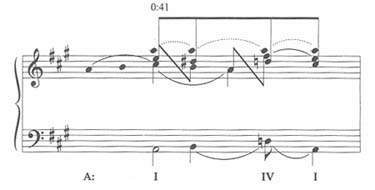
Example 4: Analytical sketch of "Eight Days a Week"
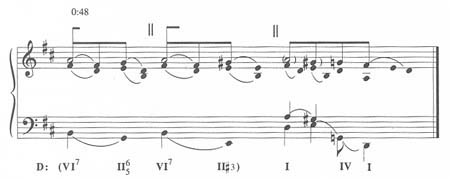
In Examples 5 through 8, the major supertonic is prepared by a strong submediant seventh chord; the chromatic line is buried in inner string parts in the concluding gestures from both "Yesterday" and "She's Leaving Home."
Example 5: Analytical sketch of "Yesterday"
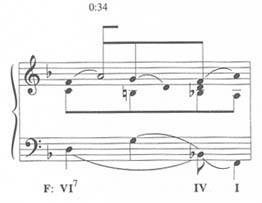
Example 6: Analytical sketch of "She's Leaving Home"
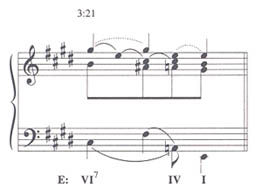
Blues inflections and alterations from mode mixture highlight Examples 7 and 8, with an applied  chord on the submediant in "I Call Your Name" and with a minor subdominant in "In My Life."
chord on the submediant in "I Call Your Name" and with a minor subdominant in "In My Life."
Example 7: Analytical sketch of "I Call Your Name"
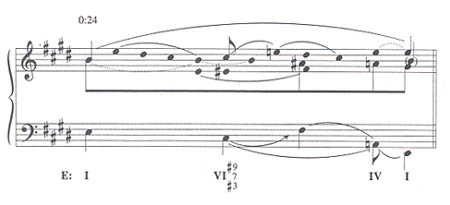
Example 8: Analytical sketch of "In My Life"
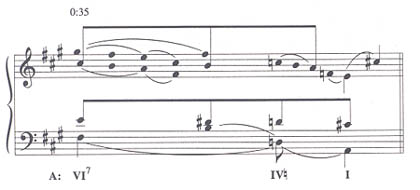
The subdominant acts not as a neighbor to tonic, but as the preparation for a dominant seventh in "Baby's in Black" (which features the chromatic descent in Lennon's vocal) and "I Don't Want to Spoil the Party" (which thoroughly disguises the chromatic descent by emphasizing non-resolving sevenths in Lennon's vocal). Each example has a different affect because of many factors, including rhythmic arrangement, but largely due to their different voice-leading characteristics.
Example 9: Analytical sketch of "Baby's in Black"
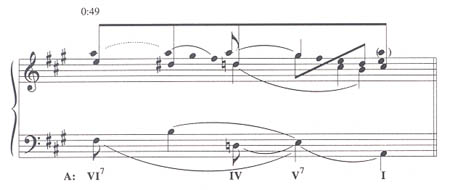
Example 10: Analytical sketch of "I Don't Want to Spoil the Party"
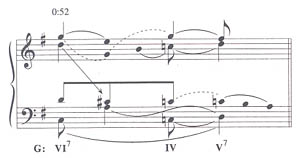
The use of a raised fourth scale degree to expand subdominant function is rather unorthodox. But the contrapuntal expansion of harmony, particularly of a subdominant or other dominant preparation, is frequently highly original in the Beatles' early music. Witness, in the chorus of "Please Please Me" (given in reduced score as Example 11 and in analytical notation as Example 12), the unusual expansion of the subdominant in measures 13-16: the root position triads that connect the bass A3 with the more powerful A2 have no grammatical connection other than in supporting a climax-building rising line from the first through fourth scale degrees with an insistent common-tone  5 and with roots that lie fifths or octaves, powerful perfect consonances, below the rising line. This is but one of many such examples.14
5 and with roots that lie fifths or octaves, powerful perfect consonances, below the rising line. This is but one of many such examples.14
Example 11: "Please Please Me"
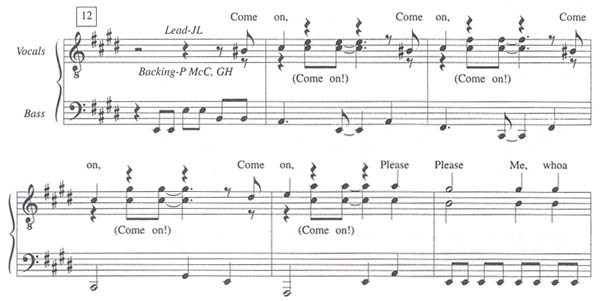
Words and Music by John Lennon and Paul McCartney. Copyright © Dick James Music Ltd.Copyright Renewed. All rights for the United States and Canada controlled by Songs of PolyGram International, Inc. International Copyright Secured. All Rights Reserved.
Example 12: Analytical sketch of "Please Please Me"
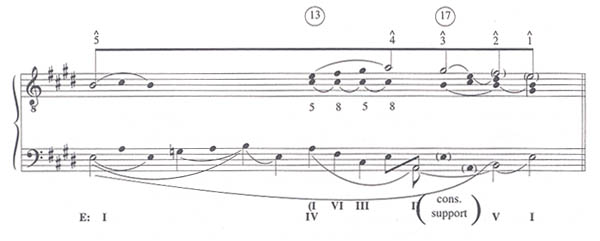
It was noted above that unlike the augmented triad that appears with a related function in "From Me to You," the falsetto dominant chord of "She Loves You," at 1:02, contains an added sixth above the root. This added B, which does not resolve back to the fifth of the chord, is otherwise reminiscent of a cadential six-four. In fact, the retransition in one of the early "sketchbook" versions of "Can't Buy Me Love" (given in Example 13) culminates in a cadential dominant with a 4-3 suspension plus the sixth added as a non-resolving neighbor to the fifth. As shown in the last measure of Example 13, Lennon's vocal E- makes it clear that the added sixth is to be understood as a neighbor to the perfect consonance.
makes it clear that the added sixth is to be understood as a neighbor to the perfect consonance.
Example 13: "Can't Buy Me Love" (Take 2)
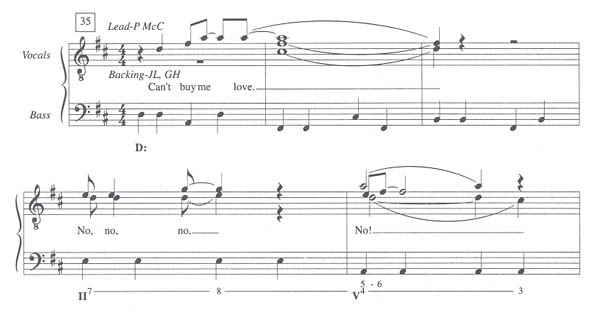
Words and Music by John Lennon and Paul McCartney © 1964 NORTHERN SONGS. All Rights Controlled and Administered by MCA MUSIC PUBLISHING, A Division of MCA INC., 1755 Broadway, New York, NY 10019 under license from NORTHERN SONGS. International Copyright Secured. All Rights Reserved.
Turning back to Example 1, the dominant decorated by an added sixth in "She Loves You" (which appears at 0:18 in the verse as well as at the second ending of the chorus), like another that concludes the retransition of "You Can't do That" (at 1:06), is a clever transposition of the more significant tonic chord with added sixth, which dominates the composition by its appearances at the end of the introduction and at the end of the coda.15 When he first heard the song, Martin counselled against the sonority, believing it to sound antiquated, reminiscent of Glenn Miller. But Harrison, who devised the sound (his only original vocal contribution to the song) by singing the E against Lennon's D and McCartney's G, stuck to his guns.16 (Rockabilly records are a far more likely model than swing music for this sonority—Carl Perkins's "Blue Suede Shoes" and "Honey Don't," both of which end with the added sixth chord, were among Harrison's favorite 1955 recordings.) The joyful chord neatly expresses the motivic crux of the song, as it includes G and E, the boundaries of the song's important reharmonized motto, and more importantly, as it telescopes the three notes, D, E, and G, of the song's title as sung at the beginnings of the introduction, the chorus, and the refrain.
The added sixth chord has just been characterized as "joyful"; in The Language of Music, Deryck Cooke equates the major sixth scale degree with "pleasure" and "yearning," and he says that "when it is exposed against the major [tonic] triad unresolved, it produces . . . the feeling of a continuous pleasurable longing, or longing for pleasure."17 In keeping with this affect, the added sixth does not seem to require resolution, but rather sustains alongside the fifth, as an imperfect consonance. The Beatles apparently consider it a full member of the tonic sonority; at 0:14 and at 0:21, the sixth scale degree appears within a bass arpeggiation of tonic (in Ex. 1c, it is bracketed and labelled as equivalent to a first inversion tonic chord; we know that this is a tonic G major chord at 0:14 despite the E in the bass, because McCartney's vocal d2 is heard as a consonance, not as a dissonant seventh). Alternatively, in the opening of the chorus, McCartney's bass arpeggiates a first inversion tonic chord spelled in the usual way. The consonant appearance of non-triadic tones in many early Beatle songs led to William Mann's notorious 1963 discussion of the "chains of pandiatonic clusters" in "This Boy"; when told of this analysis, the Beatles were mystified, and got many laughs over the years from the "aeolian cadences" and "pandiatonic clusters" that Mann ascribed to their music.18
In the pages of this journal, Robert Gauldin has recently discussed aspects of the LP Abbey Road in terms of Robert Bailey's double-tonic complex.19 This complex, sounding like a major triad with added sixth, is formed, in Bailey's own words, by "the pairing together of two tonalities a minor third apart" and functions as an axis so that "one of the two elements is at any moment in the primary position while the other remains subordinate to it."20 Despite the fact that Bailey goes on to caution the analyst that "the function of this major triad with added sixth [as heard in Wagner] should not be confused with the function of the added-6th chord in twentieth century popular music, which acts simply as a decorated triad (a triad with an extra nontriadic note),"21 it seems that the G-B-D-E sonority of "She Loves You" would be an excellent candidate for Bailey's complex. While E minor is never tonicized in "She Loves You" (not a requirement for Bailey), it often assumes a primary position over that of the tonic, as a dark shadow engulfing the brighter major mode: the song begins with an E minor chord for an auxiliary cadence, then the E minor sonority obscures the tonic for the word "bad" (0:29) and with every ubiquitous appearance of the "α" motive, and finally G major gives way to E minor for the ultimate pair of deceptive cadences (1:53 and 1:59). The final added-sixth chord is not simply "a decorated triad," but a motivic summary of many of the work's important relationships, as well as a reminder of the shadow that follows the singer's friend.22
Alongside the chromatic passing  of the motto and the
of the motto and the  and
and  that appear in Harrison's blues-derived cadential guitar lick, the
that appear in Harrison's blues-derived cadential guitar lick, the  of 0:32, 1:10, and 2:01 and the congruent
of 0:32, 1:10, and 2:01 and the congruent  of 1:11 and 2:03 are the song's remaining non-diatonic tones. As altered third and sixth scale degrees, both are products of modal mixture and exist for the purpose of contrasting, in a dramatic and ironic setting, the friend's present gloom with the gladness that he knows he should feel. At 0:32,
of 1:11 and 2:03 are the song's remaining non-diatonic tones. As altered third and sixth scale degrees, both are products of modal mixture and exist for the purpose of contrasting, in a dramatic and ironic setting, the friend's present gloom with the gladness that he knows he should feel. At 0:32,  4 appears as an altered version of
4 appears as an altered version of  4, the note to which Lennon had sung the word "bad," and so the mode mixture seems to portray the friend as moving from bad to worse, as the singer demands that he confront his emotions. After 0:32, the rise of
4, the note to which Lennon had sung the word "bad," and so the mode mixture seems to portray the friend as moving from bad to worse, as the singer demands that he confront his emotions. After 0:32, the rise of  from this inner-voice status to its suspension in the upper register sets the stage for the climactic, diatonic falsetto dominant with added sixth. If the situation has not necessarily gone from bad to worse, the role of
from this inner-voice status to its suspension in the upper register sets the stage for the climactic, diatonic falsetto dominant with added sixth. If the situation has not necessarily gone from bad to worse, the role of  in the scale-degree transformation, the registral shift, and the suspension over a structural dominant certainly convey the impression of a singer focusing ever more intently on the weightiness of his message. Mode mixture appears throughout the early music of the Beatles, as do chromatic lines and borrowings from pentatonic blues scales, almost always providing contrast to otherwise diatonic settings, as in the case of "She Loves You."
in the scale-degree transformation, the registral shift, and the suspension over a structural dominant certainly convey the impression of a singer focusing ever more intently on the weightiness of his message. Mode mixture appears throughout the early music of the Beatles, as do chromatic lines and borrowings from pentatonic blues scales, almost always providing contrast to otherwise diatonic settings, as in the case of "She Loves You."
This essay has attempted to show how Schenkerian analysis can illuminate how one of the Beatles' visceral early works coheres by virtue of structural tension and expresses its ecstatic message through dramatic registral contrasts, expansions of structural harmonies, elaborations of structural dominants, and alterations of scale degrees. All of these aspects of "She Loves You" are hallmarks of the Beatles' early style; they are occasionally revisited in their later work, but generally decline in importance in the face of greater interests in more inscrutable poetic images, more imaginative sound colors, and more original tonal and formal structures. The analysis of voice leading, with emphasis on harmony, register, and thematic design, thus yields not only serious discussion about black-and-white notes, but can also get to the heart of colorful musical expression, even that based in geniality, exuberance, and joy.
"Title" (Principal Composer) [recording date] {first U.K. release}
"All I've Got to Do" (Lennon) [11 Sep 63] {With the Beatles}
"Baby's in Black" (Lennon-McCartney) [11 Aug 64] {Beatles for Sale}
"Can't Buy Me Love" (McCartney) [29 Jan 64] {A-side}
"Day Tripper" (Lennon) [16 Oct 65] {B-side of "We Can Work It Out"}
"Drive My Car" (McCartney) [13 Oct 65] {Rubber Soul}
"Eight Days a Week" (McCartney) [6, 18 Oct 64] {Beatles for Sale}
"From Me to You" (Lennon-McCartney) [5 Mar 63] {A-side}
"A Hard Day's Night" (Lennon) [16 Apr 64] {A-side; A Hard Day's Night}
"Help!" (Lennon) [13 Apr 65] {A-side}
"I Call Your Name" (Lennon) [l Mar 64] {EP}
"I Don't Want to Spoil the Party" (Lennon) [29 Sep 64] {Beatles for Sale}
"I Saw Her Standing There" (McCartney) [11 Feb 63] {Please Please Me}
"I Should Have Known Better" (Lennon) [26 Feb 64] {Hard Day's Night}
"I Want to Hold Your Hand" (Lennon-McCartney) [17 Oct 63] {A-side}
"I Want You (She's So Heavy)" (Lennon) [22 Feb - 11 Aug 69] {Abbey Road}
"I'll Get You" (Lennon-McCartney) [l Jul 63] {B-side of "She Loves You"}
"I'm a Loser" (Lennon) [14 Aug 64] {Beatles for Sale}
"I'm Looking Through You" (McCartney) [10-11 Nov 65] {Rubber Soul}
"If I Fell" (Lennon) [27 Feb 64] {A Hard Day's Night}
"If I Needed Someone" (Harrison) [16, 18 Oct 65] {Rubber Soul}
"In My Life" (Lennon) [18, 22 Oct 65] {Rubber Soul}
"It Won't Be Long" (Lennon) [30 Jul 63] {With the Beatles}
"Misery" (Lennon) [11 Feb 63] {Please Please Me}
"No Reply" (Lennon) [30 Sep 64] {Beatles for Sale}
"One After 909" (Lennon) [5 Mar 63] {re-recorded in 1969 for Let It Be}
"Please Please Me" (Lennon) [26 Nov 62] {A-side}
"She Loves You" (Lennon-McCartney) [1 Jul 63] {A-side}
"She's Leaving Home" (McCartney) [17, 20 Mar 67] {Sgt. Pepper's Lonely Hearts Club Band}
"Something" (Harrison) [2 May - 15 Aug 69] {Abbey Road and A-side}
"There's a Place" (Lennon) [11 Feb 63] {Please Please Me}
"This Boy" (Lennon) [17 Oct 63] {B-side of "I Want to Hold Your Hand"}
"Ticket to Ride" (Lennon) [15 Feb 65] {A-side}
"Wait" (Lennon) [17 Jun, 11 Nov 65] {Rubber Soul}
"We Can Work It Out" (Lennon-McCartney) [20, 29 Oct 65] {A-side}
"Yes It Is" (Lennon) [16 Feb 65] {B-side of "Ticket to Ride"}
"Yesterday" (McCartney) [14 Jun 65] {Help!}
"You Can't Do That" (Lennon) [25 Feb 64] {B-side of "Can't Buy Me Love"}
"You Won't See Me" (McCartney) [11 Nov 65] {Rubber Soul}
"You're Going to Lose That Girl" [19 Feb 65] {Help!}
Shorter versions of this paper were presented to the conference,"Popular Music: The Primary Text," in London (July, 1992) and to the Society for Music Theory in Kansas City (October, 1992).
1Stephen Barnard, "Tell Me Why: A Beatles Commentary, by Tim Riley," Popular Music 9, no. 2 (April 1990): 251-252.
2Philip Tagg, "Analysing Popular Music: Theory, Method and Practice," Popular Music 2 (1982): 39.
3Simon Frith, Music for Pleasure: Essays in the Sociology of Pop (New York: Routledge, 1988), 75.
4Jann S. Wenner, "Lennon Remembers," in The Ballad of John & Yoko, ed. Jonathan Cott and Christine Doudna (Garden City, N.Y.: Rolling Stone Press, 1982), 103.
5Dates of recording sessions for "From Me to You" and all other songs cited in this article are given in the index. Many sources, including the authoritative Mark Lewisohn, say that "She Loves You" was written in a hotel room in Newcastle-upon-Tyne on 26 June. Chris Salewicz maintains that the song "was written on a tour bus traveling through Yorkshire earlier in the year," and Peter Brown says that the lyrics were finished "in a hotel room three nights before it was recorded" (the Beatles were performing in Leeds on 28 June). Given the certainty that the lyrics, vocal parts, and chord changes (let alone the individual instrumental voicings) were not decided upon in one sitting, there may be some truth in all of these reports—especially given the geographical proximity of the northern Newcastle and Yorkshire. See Lewisohn, The Beatles Recording Sessions: The Official Abbey Road Studio Session Notes, 1962-1970 (New York: Harmony Books, 1988), 32; Salewicz, McCartney (New York: St. Martin's Press, 1986), 153; Brown and Steven Gaines, The Love You Make: In Insider's Story of The Beatles (New York: McGraw-Hill Book Company, 1983), 105. Beatle assistant Peter Brown maintained in a personal interview with this writer (Chicago, 30 July 1983) that his dates were provided directly by Lennon and McCartney.
6For the Beatles, 1962-63 was a period of live recording, during which time George Martin sought primarily to capture the excitement of their concert performances. The first two LP's and first four singles (through "She Loves You") were recorded on two-track equipment, with occasional overdubs of double-tracked vocals, harmonica, keyboard, handclaps or an occasional lead guitar solo for "sweetening." After four-track recorders were introduced in October, 1963, the Beatles' freedom grew through the separate recording of instrumental backing and all vocals, to the isolated laying of rhythm tracks and separate recording for instrumental countermelodies as well as vocal parts. Rubber Soul (1965) saw a multitude of overdubs, and Sgt. Pepper (1966-67) required a number of bouncings-down of several generations of tape. By the time of the recording of Abbey Road (1969), the Beatles would routinely record one instrument per track (allowing the freedom to superimpose even a lone bass line or a drum part), often necessitating more than one generation of eight-track tape.
7Gloria Steinem says that while backstage for a 1964 performance, the Beatles' publicity writer, Derek Taylor, "tapped my arm just before each chorus of screams reached a crescendo. 'You can always tell,' he explained calmly. 'It happens just after one of them tosses his hair or lifts his guitar.'" Steinem, "Beatle With a Future" [1964], in The Lennon Companion: Twenty-five Years of Comment, ed. Elizabeth Thomson and David Gutman (New York: Schirmer Books, 1987), 35. Beatle historian Nicholas Schaffner says "From Me to You" introduced "yet another Beatle trademark: the falsetto 'whoooooos' linking the chorus and the verse [at both 0:48 and 1:31]. In performance the three front-line Beatles would, when they reached this part, lean toward the mikes, vigorously shaking their mop heads in unison to drive shivers up all the little girls' spines and insure that the next few bars be drowned in orgasmic shrieks." Schaffner, The Beatles Forever (New York: Cameron House, 1977), 21-22. This highly charged emotional appeal, of course, led to the riots that were dubbed "Beatlemania" in October, 1963, during the chart reign of "She Loves You." For a closer personal look at this excitement, see Cynthia Lennon, A Twist of Lennon (New York: Avon Books, 1978), 72. Listen for other falsetto climaxes, exhibiting progressively greater tension, in "Please Please Me" (1:13), "I Saw Her Standing There" (1:08 and 2:11) and "I Want to Hold Your Hand" (1:08 and 1:50).
8Structural octave shifts such as this one are featured throughout the early music of the Beatles; witness those on the first scale degree in "I Saw Her Standing There" (refrain, 0:23-0:25 and elsewhere) and "I'm a Loser" (verse, 0:19-0:20), on the second degree in "It Won't Be Long" (retransition, 0:51-0:55), on the third degree in "I Want to Hold Your Hand" (refrain, 0:19-0:22), "I Should Have Known Better" (bridge, 1:00-1:02), and "Yes It Is" (end of verse to retransition, 0:55-1:13), on the fourth degree in "You're Going to Lose That Girl" (beginning of transition to end of retransition, 0:52-1:08), on the fifth degree in "From Me to You" (retransition, 0:46-0:49) and "Wait" (opening arpeggiation, 0:00-0:01), on the sixth degree in "No Reply" (verse to beginning of bridge, 0:02 and 0:14-0:17), and on the seventh degree in "I Want to Hold Your Hand" (verse, 0:13-0:22) and "If I Fell" (introduction, 0:05-0:06).
9Other interpretations are of course possible. Tim Riley hears the "ratty" pentatonic guitar lick as part of the singer's expression of ecstatic pleasure, and presumably of his threat to steal the friend's girl if an apology does not materialize. While plausible, I believe this hearing misses out on the same drama I hear in the friend's conversion. Riley, Tell Me Why (New York: Alfred A. Knopf, Inc., 1988), 67.
10David Griffiths, "Three Tributaries of 'The River'", Popular Music 7, no. 1 (1987): 31.
11See the following analyses by this writer: "Fantastic Remembrance in John Lennon's 'Strawberry Fields Forever' and 'Julia,'" The Musical Quarterly 72, no. 3 (1986): 360-93; "Grief in Winterreise: A Schenkerian Perspective," Music Analysis 9, no. 2 (1990): 157-75; "Voice Leading, Register and Self-Discipline in Die Zauberflöte," Theory and Practice 16 (1991); "Swallowed by a Song: Paul Simon's Crisis of Chromaticism," in a forthcoming book co-edited by John Covach and Graeme Boone.
12G. Barry Golson, ed., The Playboy Interviews with John Lennon & Yoko Ono: The Final Testament . . . Interviews by David Sheff (New York: Berkley Books, 1981), 150. McCartney brought a similar desire for freshness to Lennon's melodic writing; Lennon says that Paul would tell him, "Well, why don't you change that there? You've done that note 50 times in the song." "Playboy Interview: John Lennon and Yoko Ono," Playboy 28 no. 1 (January, 1981): 86. Passages such as those cited above involving reharmonizations would seem to support Wilfrid Mellers' assertions that the Beatles' harmonies are dependent upon prior melodies. However, these are only surface-level chords that are dependent upon melodic motives; at deeper levels, as shown for instance in this article's voice-leading graphs, the Beatles' melodies compose-out prior harmonies. See Mellers, Twilight of the Gods: The Music of the Beatles (New York: Schirmer Books, 1973), 28, 41-42. McCartney was more the craftsman at music composition than was Lennon (see Martin, All You Need, 137-38); his completion of the harmonization of the coda of "Yes It Is," posited below, would fit Martin's view of both Lennon and McCartney: "most creative thoughts in The Beatles came from [McCartney]. John Lennon, on the other hand, lacked the dogged persistence for thinking out detail, and one had to search for his ideas." Martin, ed., Making Music: The Guide to Writing, Performing and Recording (New York: Quill, 1983), 267. Regarding McCartney having taught guitar chords to Lennon, see Robert Christgau and John Piccarella, "Portrait of the Artist as a Rock & Roll Star" in The Ballad of John & Yoko, ed. Cott and Doudna, 244.
13Alexander Villinger's dissertation lists a number of Beatles songs that feature the progression from a major supertonic chord to the subdominant, but his Riemannian discussion of the chord relationships does not get at the affective essence of the progression, which is the descending chromatic line in an inner voice. Villinger, "Die Beatles-Songs—Analysen zur Harmonik und Melodik" (Freiburg: Hochschul Verlag, 1983), 100-101. I would argue that the "e-minorness" of the chord (including A and  ) at 2:10 might convince the listener that even the "root position A7 chord" at 0:04 is a very different sonority from that which functions as V7 of V.
) at 2:10 might convince the listener that even the "root position A7 chord" at 0:04 is a very different sonority from that which functions as V7 of V.
14Other powerful expansions of the subdominant appear in "I Saw Her Standing There," "This Boy," and "I Should Have Known Better." Supertonic harmony is expanded contrapuntally in "There's a Place," "It Won't Be Long," "All I've Got to Do," "I Call Your Name," and "Yesterday," and the submediant is expanded in "Please Please Me," "There's a Place," "A Hard Day's Night," "I Should Have Known Better," "No Reply," "Drive My Car," "Day Tripper," "We Can Work It Out," and "I'm Looking Through You."
15The triad with added sixth appears on both dominant and tonic scale degrees in the conclusion of the twelve-string guitar solo in "I Should Have Known Better." This sonority, closely related to the rhythm guitar shuffle featured in "Misery" and "Eight Days a Week" among many others, features the sixth scale degree as neighbor to the fifth degree, a figure that is also of structural importance to most early Beatles melodies—witness the opening of the upper line in "Please Please Me" as sketched in Ex. 12. Many early Beatles songs, such as "No Reply," "Yes It Is," and "Help!" end on the tonic chord with added sixth.
16Paul Gambaccini, ed., Paul McCartney in His Own Words (New York: Quick Fox, 1976), 19. William J. Dowlding, Beatlesongs (New York: Fireside, 1989), 44.
17Deryck Cooke, The Language of Music (Oxford: Oxford University Press, 1959), 64-65, 69, 70. Cooke cites neither the ending of "She Loves You" (which of course post-dates his book) nor Glenn Miller, but the ending of Mahler's "Das Lied von der Erde" as his example.
18Vocal "pandiatonic clusters" also feature in "Yes It Is" (Lennon's admitted re-write of "This Boy"), in the car horns emulated by the singers in "Drive My Car," and in the passing vocal "triads" of "If I Needed Someone," among many other examples. See Mann, "What Songs the Beatles Sang . . ." [1963], in The Lennon Companion, 28. See Lennon's reaction in the 1971 Rolling Stone interview, reprinted in The Rolling Stone Interviews: 1967-1980, ed. Peter Herbst (New York: St. Martin's Press, 1981), 139, and Golson, ed., The Playboy Interviews, 101, 181.
19Robert Gauldin, "Beethoven, Tristan, and The Beatles," College Music Symposium 30 no. 1 (Spring 1990): 149-51.
20Robert Bailey, "An Analytical Study of the Sketches and Drafts," in Wagner: Pre1ude and Transfiguration from 'Tristan and Isolde,' ed. Bailey (New York: W. W. Norton & Company, 1985), 121-22.
21Bailey, "An Analytical Study," 122.
22The writer is grateful to Kevin Korsyn for alerting him to the applicability of the double-tonic complex in this case, and for the felicitous choice of the word "shadow."


